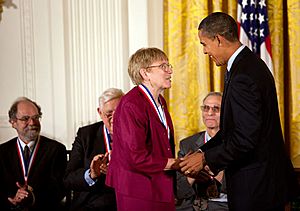JoAnne Stubbe facts for kids
Quick facts for kids
JoAnne Stubbe
|
|
|---|---|

Stubbe receiving National Medal of Science in 2009
|
|
| Born | June 11, 1946 Champaign, Illinois
|
| Education | B.S. Chemistry, University of Pennsylvania Ph.D. Organic Chemistry, University of California, Berkeley |
| Known for | ribonucleotide reductases |
| Scientific career | |
| Fields | Biochemistry |
| Institutions | Massachusetts Institute of Technology |
| Doctoral advisor | George Kenyon |
| Other academic advisors | Julius Rebek |
JoAnne Stubbe is a famous American chemist. She is well known for her important work on special enzymes called ribonucleotide reductases. These enzymes are super important for making DNA. In 2009, she won the National Medal of Science, a really big award. She used to be a professor at the Massachusetts Institute of Technology (MIT) until she retired in 2017.
Contents
Early Life and Education
JoAnne Stubbe was born in Champaign, Illinois, in 1946. She loved science from a young age. In 1968, she earned her first degree in chemistry from the University of Pennsylvania. She worked in a lab there as a student.
After that, she went to the University of California, Berkeley. She earned her PhD in organic chemistry in 1971. She then did some extra research work at UCLA.
Becoming a Researcher
JoAnne Stubbe taught at Williams College for a few years. She soon realized she loved doing research more than teaching. This led her to Brandeis University for more research. There, she learned how to create special medicines called enzyme inhibitors. These medicines can stop bad enzymes from working.
She also taught at Yale School of Medicine for a short time. In 1980, she moved to the University of Wisconsin. She became a full professor there in 1985. Later, in 1987, she joined the MIT Chemistry Department. She was the first woman to become a permanent professor in that department.
Amazing Discoveries
JoAnne Stubbe has written over 300 science papers. She is famous for her research. Before her work, scientists didn't fully understand how some enzymes worked. She changed the field of biochemistry with her discoveries.
Understanding Enzymes
Her first big papers explained how enzymes like enolase and pyruvate kinase work. These enzymes help our bodies use carbohydrates for energy. She did these important experiments in the late 1970s and early 1980s.
She wanted to know how ribonucleotides turn into deoxyribonucleotides. This change is key for making DNA. She even slept in her office sometimes because she worked so hard!
DNA and Free Radicals
Stubbe was a pioneer in using special tools to study enzymes. She spent most of her career studying how enzymes use "free radicals." Free radicals are tiny, super-active particles.
She found out how enzymes called ribonucleotide reductases use these free radicals. They change nucleotides into deoxynucleotides. This process is vital for DNA repair and making new DNA. It's like the most important step in building DNA.
Her work also helped explain how a cancer medicine called gemcitabine works. This medicine helps treat many cancers, like pancreatic cancer and breast cancer.
Fighting Cancer
JoAnne Stubbe also worked with another scientist, John Kozarich. They studied bleomycin, an antibiotic used to treat cancer. They found out how bleomycin breaks down DNA in cancer cells. This helps kill the cancer cells.
Before she retired, Stubbe continued to study ribonucleotide reductases. She also looked into special plastics called polyhydroxybutyrates. Bacteria can make these plastics, which are good for the environment. She also studied how DNA repair enzymes work.
Personal Life
JoAnne Stubbe's parents were teachers. This made her think she wanted to be a teacher too. But she found her true passion in research. She even had a pet dog named Dr. McEnzyme Stubbe! Her dog was part of her research group. It had its own email and picture on the group's website.
Recognized for Excellence
JoAnne Stubbe is a member of many important science groups:
- 1991 American Academy of Arts and Sciences
- 1992 United States National Academy of Sciences (Biochemistry section)
- 2004 American Philosophical Society
- American Chemical Society
- American Society for Biological Chemists
- Protein Society
Awards and Honors
JoAnne Stubbe has won many awards for her amazing work:
- 1986 Pfizer Award in Enzyme Chemistry
- 1989 ICI – Stuart Pharmaceutical Award for Excellence in Chemistry
- 1990 MIT teaching award
- 1991 American Academy of Arts and Sciences Fellow Award
- 1992 Myron L. Bender and Muriel S. Bender Distinguished Summer Lecturer, Northwestern University
- 1993 Arthur C. Cope Scholar Award of the American Chemical Society
- 1996 Richards Medal from northeastern section of ACS
- 1997 Alfred Bader Award in Bioinorganic or Bioorganic Chemistry of the American Chemical Society
- 1998 F.A. Cotton Medal for Excellence in Chemical Research of the American Chemical Society
- 2004 Repligen Award
- 2005 John Scott Award
- 2008 Protein Society Emil Thomas Kaiser Award
- 2008 National Academy of Sciences Award in Chemical Sciences
- 2008 Kirkwood Medal
- 2009 American Chemical Society's Nakanishi Prize for finding how radical intermediates help ribonucleotide reductases.
- 2009 National Medal of Science for her amazing experiments on enzymes and DNA.
- 2009 Prelog Medal, from the Swiss Federal Institute of Technology, Zurich
- 2010 Benjamin Franklin Medal in Chemistry for her work on free radicals and cancer treatments.
- 2010 Welch Award for her basic research in biochemistry.
- 2010 Murray Goodman Memorial Prize
- 2013 Honorary doctor of the Harvard University
- 2014 Penn Chemistry Distinguished Alumni Award
- 2015 American Chemical Society Remsen Award
- 2017 Pearl Meister Greengard Prize
- 2020 American Chemical Society Priestley Medal

